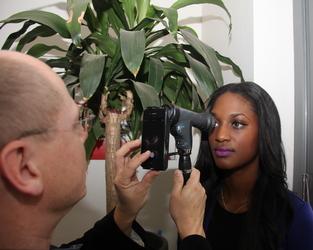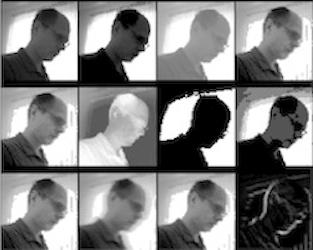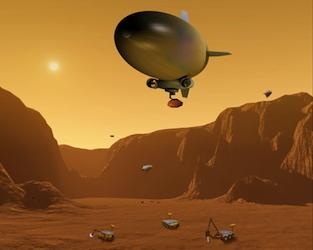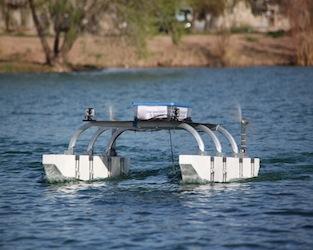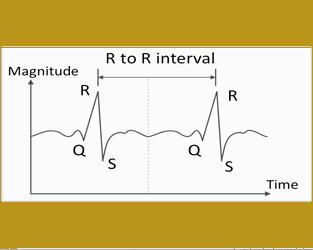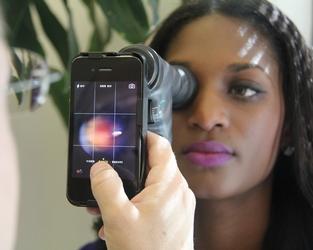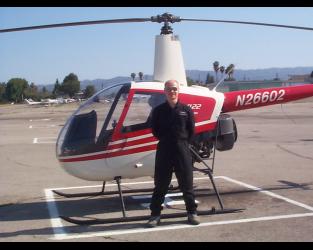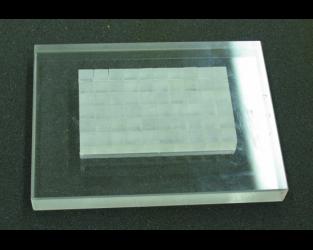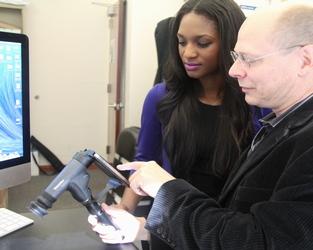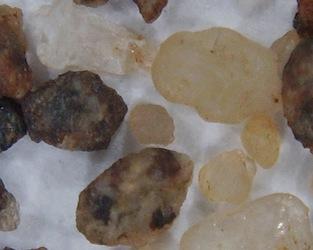"My name is Bassil Ramadan. I have worked with Dr. Fink since September 2018 while I studied my undergraduate degree in Neuroscience and Cognitive Science with an emphasis on Biomedical Engineering and a minor in Biochemistry. During my time with his lab, I have been privileged to work on developing a device to aid in navigation for persons with visual impairment. This included collaboration with other faculty, development and testing of a novel device, the presentation of research posters, and the publication of a paper in the Journal of Medical Engineering and Technology. Beyond the privilege of the work, the opportunity to have a publication as an undergraduate was unthinkable when I first began. The Visual and Autonomous Exploration Systems Research Laboratory served as a defining feature of my undergraduate career. One of the fundamental questions I brought to college was how I could build components of engineering into my research experience as an undergraduate student in neuroscience. From my first encounter, it was clear that Dr. Fink’s commitment to interdisciplinary studies would be integral to this exploration. VAESRL has given me real opportunities to think and grow as a researcher, with the help of a fantastic mentor. His curiosity, thoughtful dialogue, pragmatism, and conscious sincerity have helped me grow into academia, with both a compassion for those I want to serve and a willingness to persist in a system that too often puts barriers on both empathy and interdisciplinary research. The work that I have done during my time with Dr. Fink is something that I will carry throughout my career."
Alumni

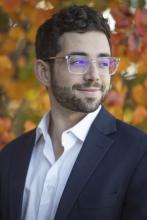
“My name is Shaun Brown and I am graduating from the University of Arizona in Spring 2021 with degrees in Biomedical Engineering and Electrical & Computer Engineering. I’ve been working with Dr. Fink since the fall semester of my freshman year (2017) focusing on integrating technology and computer analysis within the biomedical field. I never expected to gain the experience I have working alongside Dr. Fink. We explore existing standards in medicine and develop novel solutions to potentially help millions of people in the fields of glaucoma management and cardiac dysrhythmias as an immediate indicator of health. For the 2019-2020 academic year, I was awarded the UA/NASA space grant to pursue research in bioastronautics for the upcoming NASA missions. To me, nothing is more rewarding than being able to contribute to the advancement of human health and wellbeing, and I’m extremely grateful for the opportunity. Aside from the technical knowledge I’ve developed, Dr. Fink has been my mentor in nearly every facet of my professional life. Working in the Visual and Autonomous Exploration Systems Research Laboratory has led me to coauthor scientific journal articles, win awards from scientific poster expos, and explore deeply different subjects beyond the scope any textbook can teach you. As a research laboratory, being at the forefront of technology, design, and discovery is the most exhilarating experience I could have ever asked for. I’m beyond thrilled to see the world improve as a direct result of the work we are doing here and what we will accomplish in the future.”

"My name is Karm Al Hajhog, I am a Biomedical Engineering graduate from the University of Arizona. I joined Dr. Wolfgang Fink’s research lab for almost two years where I had the great opportunity to work alongside with one of the most creative and talented people I have met. My experience with Dr. Fink was the highlight of my undergraduate journey; I was able to apply and extend my knowledge and work on exciting projects that involved mathematical analysis, program writing, 3D plotting, and other valuable skills. Since I first met Dr. Fink I was immediately inspired by his innovative ideas and futuristic views. He always encouraged me to work hard, and follow my educational and career goals, and challenged me to become a better engineer. Moreover, Dr. Fink was a great mentor to me, he was supportive, kind, helpful, and our meetings were always filled with fascinating and enlightening discussions."
"My name is Qasim Mahmood and I’m an Electrical and Computer Engineering graduate student working in Dr. Fink’s lab. This lab has been my favorite internship in my undergraduate and graduate years at the University of Arizona. Dr. Fink is very fun to work with and his passion shines in our frequent discussions; it has truly been a pleasure working in this lab. Over the course of 1-1.5 years, the projects in his lab have been challenging and equally rewarding through conference publications, recognition, and opening career opportunities that would otherwise not be possible. The lab is laid out to give you responsibility of real on-going projects which allow you to broaden your horizons and gain practical experience. I primarily worked on object detection, identification, and tracking autonomous vehicles, and subsequently on a data visualization tool to further an anomaly detection framework. I would highly recommend Dr. Fink’s research to anyone interested in gaining hands-on experience interested in anything from biomedical applications to space exploration."

"My name is Alex Brooks and I am an electrical and computer engineering graduate from the University of Arizona. I worked with Dr. Fink as a software engineer for two and a half years, developing algorithms for several projects including automatic anomaly detection in images, autonomous rover navigation, simulated path planning, and Lidar visualization. The last few years have been incredible! I have had the opportunity to explore many of my interests at a very deep level, publish several papers, and access job and internship opportunities that would have been otherwise unreachable. I would highly recommend the Visual and Autonomous Exploration Systems Research Laboratory to anyone interested in engineering, especially in the context of software design, robotics, image processing, and biomedical devices. The lab has a very unique breadth of projects that can help students explore a wide variety of technical interests. Most importantly, working with Dr. Fink is very fun, and he invests lots of time in his students to help them reach their maximum potential. He is very creative in his approach to research and great at what he does! I am very grateful to Dr. Fink for everything that he has done to help me shape my career path and I look forward to seeing what his lab accomplishes in the future."
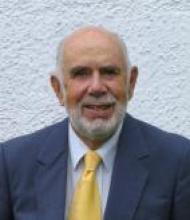
Professor emeritus Dr. Erich Schmid is a theoretical physicist and computational physicist. He is the founder of ZDV, the University Computing Center of Tübingen, Germany. Together with I. Slaus he is the founder of the European Few-Body Physics Research Committee. Dr. Schmid is known by the text books “The Quantum Mechanical Three-Body Problem” and “Theoretical Physics on the Personal Computer” with editions in English, German, Russian, and Japanese.
Erich Schmid, born 1931 in Munich, studied physics at the University of Munich and obtained his M.S. degree in experimental physics and his Ph.D. in theoretical physics under Walther Gerlach. After two post-doctoral years in Munich he became research associate at Florida State University and senior research physicist at the Max Planck Institute for Physics and Astrophysics in Munich under Werner Heisenberg. In 1965 he became full professor of theoretical atomic and nuclear physics at the University of Tübingen, Germany.
Dr. Schmid’s research started with experimental and theoretical molecular physics in Munich and changed to computational nuclear physics at Florida State University, Tallahassee. For his theoretical work he started to use computers as early as 1956. He designed mathematical models suited for computer applications (a model for extracting molecular information from Raman spectra, a Monte Carlo model for nuclear bound state calculations, the orthogonalized resonating group model for nuclear scattering calculations, the “fish-bone” model). His work includes pure mathematics (convergence-proof of the orthogonalized resonating group model) and computer applications. In 1988 he opened up a second line of research, namely computer applications in medicine, especially in ophthalmology. One of his first collaborators in this second field has been Dr. Wolfgang Fink. Dr. Schmid is first author of the above-mentioned books and of numerous refereed papers and conference contributions.
"My name is Jerri-Lynn Kincade; I’m a Biomedical Engineering graduate from the University of Arizona. I originally met Dr. Fink in my sophomore year at The University Medical Center during a Biomedical Research Seminar. We sat next to each other, exchanged a few words, and then parted ways. We then met again about a year later at a NSBE (National Society of Black Engineers) event. Dr. Fink later became the advisor of the National Society of Black Engineers and the mentor/sponsor for The Handheld Ophthalmic Device Project for the College of Engineering. I was an active member of both groups. Because Dr. Fink was such a phenomenal mentor, professor, and advisor he was able to help me grow in many areas. Dr. Fink helped me define my academic and professional goals, taught me and showed me how to successfully conduct research, provided me with advice on how to create a scientific research poster and presentation, and provided me with tips in how to improve my interviewing and public speaking skills. Dr. Fink also helped myself and other NSBE members publish a scientific article in The Journal of Pipeline Engineering (2016). Most importantly, Dr. Fink never gave up on me, he always showed genuine interest and support in my future professional goals. His words were always empowering and positive. He was never too busy to offer his time or assistance. Dr. Fink truly has made a huge impact in my life and I would like to thank him for everything he has done for me!"

"My name is Helena Hurbon, and I am a current physics undergraduate at Eckerd College on the pre-engineering track, Class of 2018. Dr. Fink is an absolute pleasure to work with. I reached out to him in September of 2014 as a potential mentor for my senior research project. While Dr. Fink was teaching classes, traveling between Arizona and California, and maintaining his love for piano playing, he still had the time to take me under his wing and work with me in biomedical engineering. He mentored me during my last trimester of high school and taught me useful research techniques that I continue to use in my undergraduate education. I worked with Dr. Fink to approximate the growth of bacteria using the Runge-Kutta method and adjusted various parameters to determine the net change in growth. Dr. Fink was continually willing to give me as much time as I needed during our meetings and answer any questions I may have had. Additionally, he worked with me on my senior research oral presentation. He is always quick to respond to emails and concerns. My experiences with Dr. Fink have been invaluable. I consider it an esteemed privilege to have been able to work with him so early in my career."
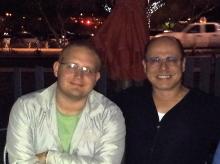
“My name is Dale E. Karas; I’m currently completing my senior year of undergraduate studies with degrees in Optical Sciences & Engineering and Music Composition, with an emphasis on piano and organ performance and added minors in Mathematics and Chemical Engineering. I met with Dr. Fink during an outreach event in Prescott, AZ while our UA engineering colleges were promoting current topics in science and technology to the public. While maintaining event materials and remotely overseeing projects still ongoing in Tucson and Pasadena, Dr. Fink still found the time to discuss my interests in a one-on-one setting and give his input on my transition to a doctoral program – beyond conversing about my academic background influencing thoughts on compositional theory and our favored Germanic opera traditions, more importantly he relayed opportunities for biomedical and electrical engineering research available to my future career, as well as how I may strive to ameliorate my programming abilities for the demands of a graduate program. Upon returning to the University of Arizona, Dr. Fink immediately offered me a lab position in the Visual and Autonomous Exploration Systems Research Laboratory for interpreting algorithms in investigating computational visual analysis for patient ophthalmic defects; this was performed by employing Caltech's 3D Computer-Automated Threshold Amsler Grid test. I felt extremely privileged to be a part of his lab group and such an assignment, supported greatly through his ardent mentoring, and I was elated for the many opportunities I could assist in his work through my own considerations for the project roles. In part from his influence, I aspire to aid in the progression of scientific research by entering a doctoral program utilizing foundational practices from optical, electrical, biomedical, and chemical engineering, as well as the possibility of working toward a medical degree in ophthalmology. I look forward to keeping up-to-date with Dr. Fink’s research, whose lab is a model for my desired post-doctoral studies, and an exemplar for the personal research I’ll conduct in the near future.”
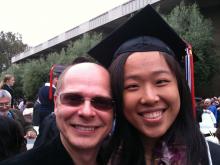
"My name is Cindy You, and I am an Applied and Computational Mathematics major at the California Institute of Technology. I worked with Dr. Fink during the summer of 2008 on determining the optimization of image processing in vision prosthesis, and during the summer of 2009 on a software package for the automated analysis of human visual field defects. My experience was rewarding in many ways; I had the opportunity to present a poster at a conference, publish two research papers, and learned much about how to conduct research. Dr. Fink's generous guidance always encouraged me explore my own ideas and provided much invaluable wisdom and expertise. I enjoyed the many meetings and discussions very much, as conversation was always interesting, enlightening, encouraging, and above all, friendly. My research experience with Dr. Fink was one of the highlights of my undergraduate education."



